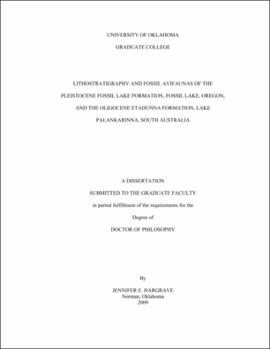| dc.contributor.advisor | Soreghan, Michael J||Cifelli, Richard L | |
| dc.creator | Hargrave, Jennifer E. | |
| dc.date.accessioned | 2019-05-01T17:24:35Z | |
| dc.date.available | 2019-05-01T17:24:35Z | |
| dc.date.issued | 2009 | |
| dc.identifier | 9913392502042 | |
| dc.identifier.uri | https://hdl.handle.net/11244/319472 | |
| dc.description.abstract | Lacustrine sediments of the Pleistocene Fossil Lake Formation of Oregon, and the Oligocene Etadunna Formation of South Australia record packages of upwardly fining sequences that are fossiliferous, including fossil birds. These two paleo-lakes were studied to determine whether stratigraphically collected bird fossils, in conjunction with lithostratigraphy, are a useful tool to infer broad past climatic conditions of ancient lacustrine systems. To do so, depositional environments are inferred from facies analysis of both lake sections and the stratigraphically collected fossil bird bones were identified to the lowest taxonomic group possible, and then grouped into ecologic groups for analysis of changes in abundances and diversity. | |
| dc.description.abstract | The Fossil Lake Formation is divided into four facies; (i) Conglomeratic Sandstone/Siltstone Facies; (ii) Cross-bedded Siltstone Facies; (iii) Siltstone Facies; and (iv) Mudstone Facies. Eight depositional packages were deposited from 646 ka to approximately 10 ka (Martin et al., 2005) as the lake waxed and waned. The facies data suggest the lake experienced periods of gradual deepening followed by abrupt shallowing. The fossil avifauna recovered from the Fossil Lake Formation reveal that shallow-water birds are consistently the most abundant overall. Fossils of diving birds are most abundant in the finer-grained sediments. Geochemically dated tephra dates within the formation allow for correlation to other regional climatic data and the global Marine Isotope Stages. Based on these correlations, the Fossil Lake Formation was primarily deposited during pluvial episodes. | |
| dc.description.abstract | The Etadunna Formation is dominated by siltstone and is divided into three facies: (i) Brecciated and Fossiliferous Siltstone Facies; (ii) Siltstone with Root Traces Facies; and (iii) Dolomitic Mudstone Facies. Four depositional packages record the rapid in-filling and gradual shallowing of the lake system. Relatively few bird fossils were recovered from the Etadunna Formation and most of the Anseriformes were unavailable for this study. Nevertheless, the fossil avifauna from this study was divided into the same three eco-groups as in the Fossil Lake study. The shallow-water birds were the most abundant, and only a single specimen from the diving bird eco-group has been recovered, suggesting that the lake was likely shallow during most of its history. | |
| dc.description.abstract | As with many fossil collections, inferences made solely from fossil avifauna may be limited, because of sample size or taphonomic biases. However, stratigraphic collections of avifauna can be combined with other datasets, such as lithologic data, to better construct broad past paleoenvironmental conditions, such as water depth. In this study, the fossil avifauna of both formations are in agreement with the interpreted depositional environments. | |
| dc.format.extent | 288 pages | |
| dc.format.medium | application.pdf | |
| dc.language | en_US | |
| dc.relation.requires | Adobe Acrobat Reader | |
| dc.subject | Geology, Stratigraphic--Pleistocene | |
| dc.subject | Geology, Stratigraphic--Oligocene | |
| dc.subject | Geology--Oregon | |
| dc.subject | Geology--Australia--South Australia | |
| dc.title | Lithostratigraphy and Fossil Avifaunas of the Pleistocene Fossil Lake Formation, Fossil Lake, Oregon, and the Oligocene Etadunna Formation, Lake Palankarinna, South Australia | |
| dc.type | text | |
| dc.type | document | |
| dc.thesis.degree | Ph.D. | |
| ou.group | Mewbourne College of Earth and Energy::ConocoPhillips School of Geology and Geophysics | |
